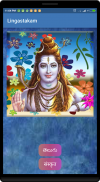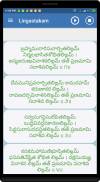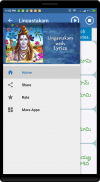







Lingastakam

Descrição de Lingastakam
A short introduction
Lingashtakam is a hymn in praise of Sri Siva, also called Maheswara, Rudra, Pasupati etc. The Linga is a symbol for Siva, just like Sankha and Chakra are symbolic of Sri Vishnu. Linga also means the gender of a being. We have Stree Linga (Female gender), Pumlinga (Male Gender) and Napumsaka Linga (literally non-male Gender, but meaning neutral gender). Linga has also become over the ages, a symbol of manliness, the erect phallus, and it is appropriate since He is the Adi Purusha. While Para Brahma is considered to be Nirguna, i.e. without any discernible attributes, once He/She/It decides to manifest in Saguna form (for reasons beyond our intelligence), we have Purusha (male) and Prakriti (Nature, considered to be feminine). And we have the Trinity (the creating, preserving and destroying aspects) of Devas and Devis, Brahma, Vishnu and Siva in the male aspects and Saraswati, Lakshmi and Parvati in their female aspects, their consorts.
Uma breve introdução
Lingashtakam é um hino em louvor de Sri Siva, também chamado Maheswara, Rudra, Pasupati etc. O Linga é um símbolo para Siva, assim como Sankha e Chakra são simbólicos do Sri Vishnu. Linga também significa o sexo de um ser. Temos Stree Linga (sexo feminino), Pumlinga (Masculino Sexo) e Napumsaka Linga (literalmente Sexo não-masculino, mas que significa gênero neutro). Linga também se tornou ao longo dos tempos, um símbolo de masculinidade, o falo ereto, e é adequada uma vez que Ele é o Adi Purusha. Enquanto parabrahman é considerado Nirguna, ou seja, sem quaisquer atributos perceptíveis, uma vez que ele / ela / você decide se manifestar de forma Saguna (por motivos alheios a nossa inteligência), temos Purusha (masculino) e Prakriti (Natureza, considerado feminino ). E nós temos a Trindade (a criação, preservação e destruição aspectos) de Devas e Devis, Brahma, Vishnu e Shiva nos aspectos masculinos e Saraswati, Lakshmi e Parvati em seus aspectos femininos, seus consortes.





















